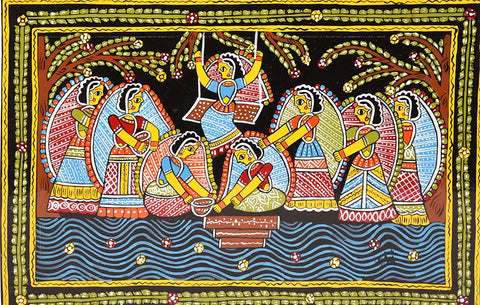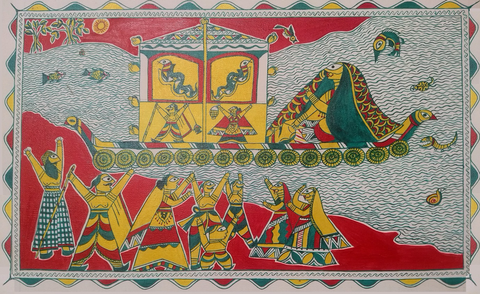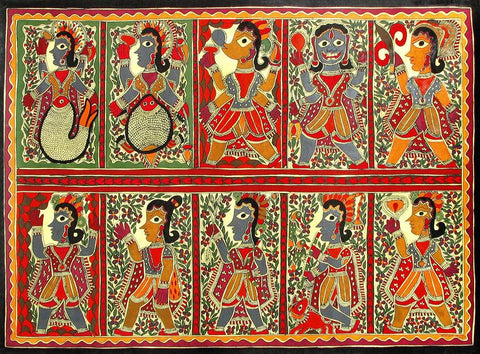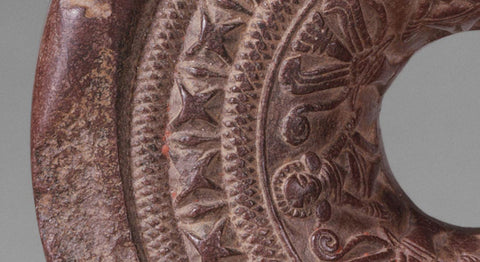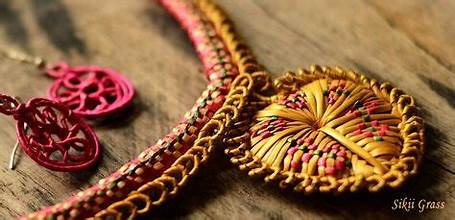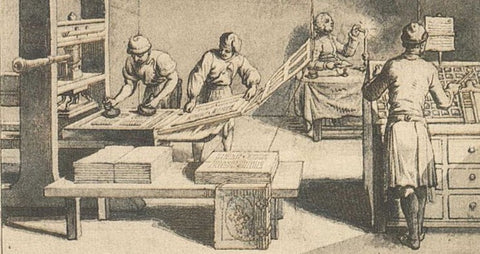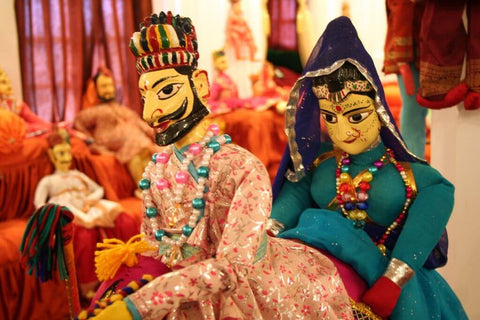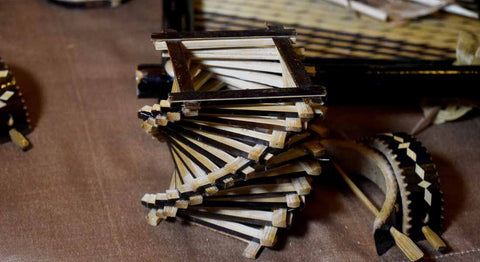Bihar, despite being home to an eclectic cultural treasure trove, is often overlooked-a fact that might not come as a surprise for many of us. This state, the very land where Lord Buddha attained his enlightenment, was also once globally renowned for its prestigious Nalanda University. Infact, the name Bihar comes from the Sanskrit word vihar, meaning monasteries, highlighting the influence of Buddhists and other such communities in the state’s ancient past. Besides the widely known Madhubani, Bihar has been nurturing some of the incredible forms of arts and crafts through the centuries! Explore with us the art and regional traditions that grace the soil of Bihar.
1. The gorgeous Tikuli craft
Tikuli- The 800-year-old artform
Tikuli art, featuring the recurrent use of Bindu-shape is one of the oldest colorful artforms of India.Traditionally, its vibrant designs and motifs are created using broken glasses which are melted and molded into designs. The roots of this ethnic artform can be traced back to the bindi-designs worn by the 17th-century women. In 1954, Upendra Maharathi played a pivotal role in reviving this 800-year old artwork. While the art may appear simple with arrangements of dots and uncomplicated patterns, the preparation of Tikuli is not one of the easiest tasks. Here, the artisans select a hardboard, and apply at least 4-5 layers of enamel. After each layer, they meticulously rub the board with sandpaper to achieve a polished and even appearance. Once the final coat is applied, the artisans proceed to paint the Tikuli. They may also use gold foils for final touches. In today’s time, Tikuli art form is serving as a source of empowerment for the women artisans in Bihar.Upon closer consideration, it becomes evident that this artform has not only been empowering women in contemporary times but has been women-centric since its inception.
2. The practice of Manjusha kala
Bihula taking the body of Bal Lakhendra on a boat, covered with Manjusha box(Courtesy:Bihar Museum; Artist: Ulupi Kumari)
It is believed that Manjusha artform dates back to 2600 BC. Manjusha, in Sanskrit, means box. The Manjusha box is said to represent the container that is said to have covered the body of Bala Lakhendra in the story on Bihula- Bisahari. Majusha art typically portrays the regional folk tales, including the story of Bahula saving her husband from a deity’s wrath and a snake bite. It also delves into the legend of the five Manasa sisters- how five strands of hair of Shiva transformed into 5 lotuses and then into five women- the Manasa sisters. The other important element of Manjusha art is its wide and vivid borders. Each work must have one or more borders, ranging from belpatra (sacred leaves), Lehariya (waves), to Srp ki ladi (snake patterns). One typical feature of Manjusha art is its incorporation of pink, green and yellow. This artform, which has its origin in AngPradesh or Bhagalpur, was carved by only two families at its inception.
3. Madhubani of Mithila
It is impossible not to talk about Madhubani when we are talking about the aesthetics of Bihar. The word Madhubani literally translates to ‘honey forest’. Widely practised in the Mithila region of Bihar, the predominant themes of Madhubani encompasses Hindu deities and episodes from Ramayana and Bhagavad Gita, as well as rural life, love and fertility. There is a belief that Janaki, or Goddess Sita requested that her wedding be documented in the form of paintings, and thus, Madhubani art was born. Originally, these lively paintings were created on mud-walls and soil-ground by the village women on certain auspicious occasions. Consequently, Madhubani paintings consisted of two forms: Bhitti Chitra (paintings done on walls) and Aripana (paintings done on grounds). Overtime, Madhubani gained worldwide recognition for its distinctive style and began to be integrated into other items.
4. Patana Qalam- Where Cultures Converge
Patana Kalam painting from 19th century
Stunning in its intricacies and beauty, Patna Qalam stands as one of the forgotten art forms. This breathtaking school of painting flourished during the 18th to mid 20th century, drawing inspiration not only from the realism of European artistry but also incorporated the intricacies of Persian and Mughal styles. Patna Qalam served as a visual historical document for literary texts. Commoners and their lives, local festivals, and ceremonies were recurrent themes in this school of art. You can see a good blend of subtle colours against the beige or whitish backgrounds. While Mughal-style paintings have rich and elaborate landscapes, the backgrounds of Patna Qalam are quite plain. These paintings were done directly on paper, using black ink and a fine brush, without any use of a sketch guide, this process is commonly referred to as Kajli Seahi. Alas, the advent of photography has been the primary cause of the setback in the thriving of this school of painting.
5. Stone Crafts of Bihar
Department of Asian Art. “Mauryan Empire (ca. 323–185 B.C.).” In Heilbrunn Timeline of Art History. New York: The Metropolitan Museum of Art, 2000–. http://www.metmuseum.org/toah/hd/maur/hd_maur.htm (October 2000)
The Gaya town of Bihar offers a diverse range of stonecraft. Stonecraft is a longstanding tradition in Bihar, with roots tracing back to ancient times, reaching its zenith during the Mauryan times. Not limited to Gaya, major centres like Patna and Nalanda also boast a wide array of stone-carving. Ancient Ashoka pillar at Sarnath is an excellent example of this rich tradition.
6. The earthiness of Sikki craft
Sikki Jewellary
Sikki or the seasonal golden grass of Bihar, grows in the wet and marshy areas of Madhubani District. A native tribe of Bihar, Amas, has mastered the art of harvesting and processing the grass. The grass is then sold by the traders at the weekly haat or market. Each Sikki product starts with the base frame of Munj. Takua is dexterously woven around the Munj. Traditionally, these lovely handcrafted products are made by brides-to-be who take these to their husband’s house as a part of dowry. Due to their characteristic sturdiness and durability, items such as boxes, bangles and baskets are crafted from this grass.
7. Lacquerware

From the Harrappan era and the Mauryans, upto the present day, bangles have remained a significant part of Indian culture. The lac bengals are popular among the married women of Bihar. Apart from Bihar, these bengals are also made in West Bengal, Odisha, Maharashtra, and Madhya Pradesh by the Laheri or Lakhera community. Large quantities of raw lac and shell lacs are harvested from the forest of Bihar. First, the dry ingredients that include lac, safed mitti (clay), abrak (talc powder), and others, are made into a dough-like lump. Coloured molten lac is combined with the dough to create a marbleized base-pattern. The lump is rolled, cut and shaped into bangles. Lastly, embellishments such as gold foil and glass beads are used for the final touch. Fish, chakra, dancing peacocks are some of the motifs that adorn these one-of-a-kind bangles.
8. The essence of Sujani embroidery
The Bhusura village of Bihar is known for its Sujani or Sujini embroidery. Sujani is formed from the two words “su” which means facilitating, and “jani” meaning birth. The art of Sujani has been mainly practised by the women of the Madhubani and Muzaffarpur districts. New mothers stitch together patches of colourful old clothes for their babies; then, motifs are sewn on this quilt, and finally, Sujani embroidery is done using threads. Some of the Sujani motifs are sacred animals, floral designs, and fertility symbols. Since its inception, Sujani embroidery has never been a commercial activity; instead, it is a craft that village women practise in their spare time, although not as frequently as in the past.
Did you know that Sujani is said to have originated around the 1920s among Rajput women?
9. The minimalism in Kantha Embroidery
The Kantha embroidery’s playful touch with its simple running stitch technique, is just perfect for whipping up lovely bedspreads and warm quilts in no time! Back in the day, women of Bihar would craft Kanthas using old cotton sarees, lungis, and dhotis that had become super soft from years of wear. They even pulled stitching thread right from the fabric itself! Over time, more elaborate patterns emerged; these new, elaborate patterns were termed as “nakshi kantha”. While running stitch Kantha is quite common, there are other techniques that have evolved over time. Sujani Kantha and Anarasi Kantha are some of the local variations. In the heart of most traditional kanthas, one can find the sun, lotus, characters from folklore and elements inspired by nature. Originating in the rural regions of Bengal, this art experienced a revival in the early 19th century due to the efforts of Pratima Devi, daughter-in-law of the renowned Noble laureate, Shri Rabindranath Tagore. After the partition of India in 1947, it faced another decline, but today institutions are working hard to bring it back to its former glory.
10. The remarkable craft of Bawan Buti
One of the oldest weaving techniques of the ancient city of Nalanda is Bawan Buti. “Bawan Buti '', as implied by its name, refers to 52 distinct motifs or butis woven into sarees during ancient times. These motif-laden sarees were then presented to daughters at the time of their weddings. Another interesting anecdote pertaining to those fifty two motifs is derived from the Vaman Avatar of Vishnu. Lord Vaman, believed to be the size of 52 fingers, acquired the entire universe in three steps. These 52 motifs in a typical 6 yards of a bawan buti saree stand as a stunning reminder of the beauty inherent in this belief within the weaver community! The loom comprises Tana (vertical) threads, which extends along the length of the product, while the weaver works on the Bana (horizontal) threads. The old tradition of Bawan Buti requires a robust revival as it teeters on the brink of being lost. In today’s time, women are serving as the backbone of the weaving craft because they are the major contributors of the families involved in this.
11. Zari works of Bihar
The dazzling world of zari zardozi was first introduced in the Indian subcontinent in the 12th century CE. This is not just the finest but an ornate style of embroidery where sequins, pearls, gemstones are woven with gold and silver metallic threads. Needless to say, during its inception, zari works were highly patronised by the affluent and courtly classes. Time, labour, and attention to details are indispensable in the traditional zari ka kaam or zari work. The karigars or artisans of Patna are well-known for the alluring zari embroidery. Peacocks, paisley designs, and flowers are some of the prominent and most commonly seen zari motifs, along with other intricate and complex designs. Throughout the needlework process, the zari karigars sit on the floor around the adda, a frame holding the fabric, dedicating their craftsmanship and time to their magnificent creation.
12. The legacy of Khatwa Applique
Khatwa applique is more than a mosaic of colours; it carries a legacy of generations. Artisans in Bihar, intricately stitch fabric onto a base using a traditional technique, like running stitch, chain stitch, and satin stitch. The play by ear technique involves simple, spontaneous arrangement of materials. However, a more intricate design involves careful planning, including the selection of specific designs, threads, materials, and sizes beforehand. For generations, this art of weaving has been a vital source of livelihood for countless rural women in Bihar.
13. Block Printing
While woodblock printing originated in China around 4,000 years ago, it was in India that the artform found home and flourished. States such as West Bengal, Orissa, and others in Eastern India played a significant role in nurturing this amazing technique. Although block printing is a specialty of Rajasthan, Gujarat and even Punjab, Bihar also has its own tradition. Block prints are created when designed wooden blocks are pressed onto fabrics. Don't mistake printing for just about stamping blocks on fabric; it goes beyond that. It involves several steps in between, such as deftly carving wooden blocks, to preparing fabric, mixing dyes and handling other intricate details and designs. These meticulously hand-carved blocks play a central role in block-printing techniques. Wooden block printing is particularly popular in Patna and Darbhanga.
14. Bihari Paper-Mache
The art of paper mache has its roots in Kashmir, where it was first said to have been introduced by Sultan Zain- ul- Abdin in the 15th century CE. Traditionally, Bihari paper mache craft was used to prepare masks for the famous Chhau dance in Bihar as well as in the making of dolls. However, the art evolved as time changed. Today, paper mache is also crafted for various utility objects. Madhubani paper mache is made using multani mitti (fuller’s earth), newspapers or old papers, methi (fenugreek seeds) powder and adhesive which includes water and wheat flour. A dough is made out of it, which is moulded into shapes, and once dried, the creation is brought to life using colours. These paper mache items are so adorable that you can feel the innocence of the makers tucked right into them!
15. The art behind Yampuri puppetry
The word “Yampuri '' consists of 2 words “Yama”, which means the Hindu God of death and “Puri”, which means abode. Thus, the word translates to “the abode of the God of death”. While Yama and Chitragupta, the record keeper of mortals’ deeds takes the centre stage, Vidushaka (the clown) and sage Narada accompany them. In contrast to the traditional rod puppets commonly found in West Bengal and Orissa, these puppets are crafted from wood as one cohesive piece. During the show, the puppeteers sit in trench-like spaces backside, manoeuvring the movements of the puppets through the use of strings. The puppetry playfully aims to depict the ways of Gods to humanity and instil a sense of morality among the spectators. Unfortunately, Yampuri puppetry faces the risk of cultural decline due to its geographic confinement and lack of promotion.
16. Beautiful Brass works
The brass work of Bihar is a continuation of the brass craft from the ancient period. This art form was at its peak during the Mauryan period and again during the Gupta and Pala periods. From iron -pitchers to divine figurines, brass craft has been readily used for versatile purposes. Yet, behind this magnificent artistry lies a contemporary challenge - small manufacturing units lack proper government support. The seamless flow of raw materials is not guaranteed, leaving these artisans in a quest for accessibility.
17. Wood Carvings
Another notable ancient craft popular in Bihar is wood carving. Gaya stands as a primary hub where this art and craft enjoys a substantial demand. Many parts of Bihar and Uttar Pradesh are also major centres for these polished and incredible wooden sculptures. Ideally, Gambhar wood is the main raw material employed in the process of wood carving.
18. Bamboo and Cane Crafts of Bihar
Bamboo craft is another integral aspect of Bihar’s artisanal tradition. The abundant accessibility of bamboo canes in the Taria and Bhabhar regions of Bihar is the central reason behind their ample and versatile use. Utility items such as baskets, mats, and chairs are made with so much dexterity by the tribal folks of Bihar, or the Bhotiyas, that their deftness is visible. These artisans skillfully blend Japanese technique with the Indian tradition, giving rise to a craft that is both familiar and distinct at the same time. Just think, this level of creativity has been a part of Bihar since the Mauryan and Gupta empires! Needless to say, in the face of climate change and pollution, it is increasingly imperative for each one of us to use sustainable alternatives like bamboo and cane products instead of plastics. By doing so, we will not only be contributing to the environment but also to the livelihood of the makers involved in such trades.
Bihar’s cultural wealth is evident in its vibrant arts. These traditions need more recognition and support from the governments and NGOs. Yet, it remains our collective responsibility to personally engage, understand, and pass down this rich, cultural knowledge to the coming generations.
- Thatavarthi, Gayathri. “Exploring the Art and Craft of Bihar - the Land of Monasteries.” Caleidoscope, December 25, 2023. https://www.caleidoscope.in/art-culture/art-and-craft-of-bihar.
- “Patna Kalam Paintings.” SELF STUDY HISTORY, April 18, 2020. https://selfstudyhistory.com/2016/04/25/bpsc-general-studies-patna-kalam-paintings/.
- Sarkar, Vaaswat. “Patna Kalam: How an Indian Art Tradition Fused Mughal and European Aesthetics.” Homegrown. Accessed February 2, 2024. https://homegrown.co.in/homegrown-creators/patna-kalam-the-forgotten-indian-art-tradition-that-fused-mughal-and-european-styles.
- Banerjee, Srijoyee. “Arts, Handicrafts, and Paintings of Bihar.” Buy Indian Arts, Crafts and Traditional Products | ARTSofINDIA.in, August 29, 2021. https://www.artsofindia.in/arts-of-india-blog/post/indian-arts-and-crafts/indian-states-arts-and-crafts/bihar-arts-and-crafts/arts-handicrafts-and-paintings-of-bihar.html.
- Kumar, Sujeet. “Exploring the Traditional Art and Crafts of Bihar: A Window to the State’s Rich Cultural Heritage.” Bihar Culture, April 29, 2023. https://www.biharculture.in/exploring-the-traditional-art-and-crafts-of-bihar-a-window-to-the-states-rich-cultural-heritage/.
- Singh, Gurvinder. “Tikuli Art - Born from Bindis.” Village Square, August 22, 2022. https://www.villagesquare.in/tikuli-art-born-from-women-bindis-seeing-revival/.
- “Sikki/ Golden Grass Craft of Bihar.” Asia InCH – Encyclopedia of Intangible Cultural Heritage. Accessed February 2, 2024. https://www.asiainch.org/craft/sikkigolden-grass-craft/.
- Jitendra and Jitendra. “Sikki.” Story of Indian crafts and craftsmen, October 12, 2013. https://gaatha.com/sikki-grass-craft-bihar/.
- “Story of Bihula Bishari - बिहुला विषहरी की गाथा.” मंजूषा कला, December 30, 2019. http://www.manjushakala.in/manjusha-art/story-of-bihula-bishari/.
- About Manjusha painting, Bihar - Esamskriti. Accessed February 2, 2024. https://www.esamskriti.com/e/Culture/Indian-Art/About-MANJUSHA-Painting,-Bihar-1.aspx.
- “Lac Bangles, Jewellery and Jewelled Objects of Bihar.” Asia InCH – Encyclopedia of Intangible Cultural Heritage. Accessed February 2, 2024. https://asiainch.org/craft/lac-jewellery-of-bihar/.
- Singh, Chandra Shamsher Bahadur. “Madhubani Paintings: People’s Living Cultural Heritage.” World History Encyclopedia, February 1, 2024. https://www.worldhistory.org/article/1527/madhubani-paintings-peoples-living-cultural-herita/.
- “Bamboo and Cane Craft of Bihar.” Folkartopedia, May 7, 2020. https://www.folkartopedia.com/crafts/bamboo-and-cane-craft-of-bihar-sk/.
- Banerjee, Trisha. “The Exquisite Art of Bamboo and Cane in Bihar - by Trisha Patna Diaries.” Patna Diaries, August 21, 2021. https://www.patnadiaries.com/the-exquisite-art-of-bamboo-and-cane-in-bihar/.
- “(Khatwa) Applique.” IndianKaarigars, September 26, 2023. https://indiankaarigars.com/portfolio/khatwa-applique/.
- “Bawanbuti- 52 Sparks from Bihar.” BAWANBUTI- 52 Sparks from Bihar. Accessed February 2, 2024.


